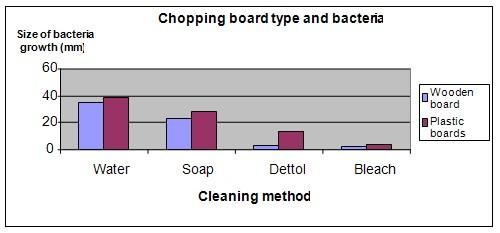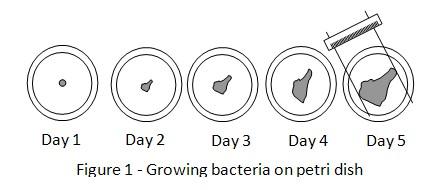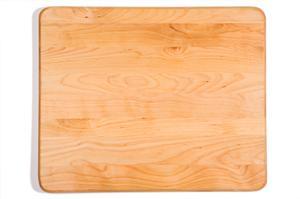| Complexity level: | 7 |
| Project cost ($): | 20 |
| Time required: | 1 day to prepare, 5 days for science fair project |
| Material availability: | Easily found |
| Safety concerns: | The bacteria should be destroyed before it is disposed of. Pour some bleach into the petri dish to kill all of the bacteria before disposal. |
Hypothesis
Wooden chopping boards have less bacteria compared to old plastic chopping boards.
Overview
Chopping boards
Chopping boards are an essential item in any kitchen. They are used to cut meat, vegetables, fruits or bread. Chopping boards need to be kept clean in order for them to be used safely. It is best to separate the chopping board used for cutting meat, from boards used for cooked food and food that is to be eaten immediately like bread, fruit or fresh vegetable salads. This is to prevent cross contamination.
Both wooden and plastic chopping boards are safe to be used as long as they are properly cleaned. However it is believed that wooden chopping boards are safer because any bacteria on the surface of the board will be pulled into the wood by capillary action. The bacteria will be unable to multiply once it is inside the wood and eventually they will die.
Plastic boards are not porous and therefore have surfaces that are easier to clean. However, under normal usage, scars will be left on the board's surface and this creates a place for the bacteria to grow and multiply. Therefore old and scarred plastic chopping boards should be disposed of as soon as signs of damage/scarring appears.
Scientific Terms
Materials
The materials required for the science fair project experiment:
- 8 agar petri dishes
- 8 disinfected swabs
- 1 bottle of disinfected water
- 4 used plastic chopping boards
- 4 used wooden chopping boards
- tap water
- 1 bottle dishwashing soap
- 1 bottle of Dettol soap
- 1 bottle of bleach
- 8 pieces of chicken
- 1 knife
- 1 marker pen
Procedure
1. For this science fair project, the independent variable is the type of chopping board and the method of cleaning the chopping board. The dependent variable is the size of the bacteria colony in the petri dish. This is determined by measuring the size of the bacteria growth using a ruler. The constants (control variables) are room temperature, the amount of sunlight and the ingredients in the petri dish.
2. The 8 petri dishes that are prepared using the agar are stored in a refrigerator. The petri dishes are brought to room temperature before the start of the science fair project by taking them out of the refrigerator and allowing them to attain room temperature. The petri dishes are labeled W1, W2, W3 and W4 for wooden chopping boards. The remaining petri dishes are labeled P1, P2, P3 and P4 for the plastic chopping boards.

3. The 4 wooden chopping boards and plastic chopping boards are labeled 1, 2, 3 and 4. One piece of chicken is placed on each of the 8 chopping boards and it is cut several times using the knife.
4. The chopping boards are cleaned as follows according to their number :
1 – wash only with water
2 – wash with water and dishwashing soap
3 – wash with water and dettol solution
4 – wash with water and bleach
5. The sterilized swab is first dampened using the sterilized water. The swabs are rubbed over the plastic and wooden chopping boards and then rubbed on the petri dishes according to their numbers. For example, wooden chopping board 1 will the rubbed using the swab and then rolled on petri dish labeled W1.
6. The cover is closed and the 8 petri dishes are kept in a cool dark place for the bacteria to grow.
7. The diameter of the bacteria colony is measured after 5 days and recorded in the table below.


Results
The results show that the wooden boards have less bacteria compared to the plastic boards no matter what method of washing is used. It is also observed that bleach is the most effective cleaner for the removal of bacteria from the chopping board's surface.
|
Used chopping board |
Size of bacteria growth after 5 days (mm) |
|||
|
Water |
Soap |
Dettol |
Bleach |
|
|
Wooden board |
35 |
23 |
3 |
2 |
|
Plastic boards |
39 |
28 |
14 |
4 |
The chart below represents the results of our science project experiment.

Conclusion
Our hypothesis has been proven to be true. Wooden chopping boards have less bacteria compared to old plastic chopping boards.
Also consider
This science fair project may be repeated, this time, with different types of boards like ceramic or glass.
Modify the science project experiment, using other cleaning agents such as antibacterial soap, Listerine or Clorox.
References
Wooden versus plastic cutting boards - http://www.reluctantgourmet.com/cutting_board.htm
Chopping boards - http://www.homeimprovementpages.com.au/article/Chopping_Boards

